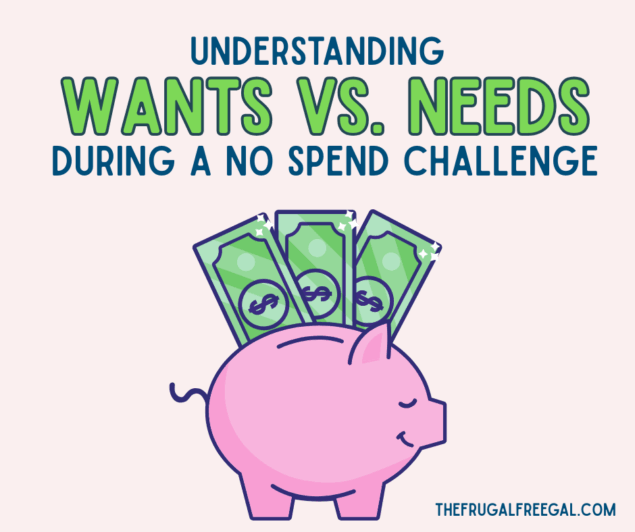
If you’re looking to save money, reset your spending habits, or take control of your finances, a no spend challenge might be just the thing you need.
Whether you’re on a tight budget, trying to pay off debt, or just want to curb impulse spending, this guide will walk you through everything you need to know—especially how to tell the difference between wants and needs during a no spend month.
What Is a No Spend Challenge?
A no spend challenge is a commitment to not spend money on anything outside of essential needs for a set period of time.
Common time frames include:
- A no spend week
- A no spend 30 day challenge
- A no spend weekend
- A no spend month
- Even a no spend year (for the truly bold!)
The goal? Break bad money habits, become more aware of your purchases, and find contentment with what you already have.
Who Should Do a No Spend Challenge?
A no spend challenge is great for anyone trying to save money fast or get back on track financially. It’s especially helpful for:
- Families on a budget
- People trying to cut unnecessary spending
- Those working toward financial goals like paying off credit cards, building an emergency fund, or saving for a big purchase
- Anyone who feels like they’re constantly asking “Where did my money go?”
When Is the Best Time to Start a No Spend Challenge?
You can start a no spend challenge anytime, but here are popular times for starting a no spend month:
- After the holidays (to recover from overspending)
- At the beginning of the year (as a financial reset)
- Back-to-school season (to limit shopping temptation)
- During a specific savings goal (like planning a vacation or paying off debt)
- At the start of a new month (starting at the beginning is a great way to reset spending habits)
Pro tip: Avoid starting during major life events, birthdays, or holidays unless you’re confident you can stay focused.
Why Do a No Spend Challenge?
There are many benefits of doing a no spend challenge:
- You’ll identify your spending triggers
- You’ll learn how much you actually need vs. want
- You’ll become more resourceful
- You’ll save money without needing to increase your income
- You’ll gain a better understanding of your financial habits
How Does a No Spend Challenge Work?
It’s simple in concept:
- Set your time frame – decide how long you’ll challenge yourself.
- Define your rules – what expenses are allowed (needs), and what aren’t (wants)?
- Track your progress – write down every time you avoid a purchase.
- Reflect at the end – review how much you saved and what you learned.
The Heart of the Challenge: Wants vs. Needs
The most important part of a no spend challenge is being honest about what’s truly a need and what’s a want. It’s the foundation of your success.
What Are Needs?
Needs are essential to survival and basic well-being. These are non-negotiables in your spending.
Examples of needs during a no spend challenge:
- Housing: Rent or mortgage
- Utilities: Electricity, water, gas, internet (if required for work or school)
- Groceries: Basic food to feed yourself or your family
- Transportation: Gas, bus fare, car maintenance (only if needed)
- Healthcare: Medicine, doctor visits
- Basic hygiene items: Soap, shampoo, toilet paper
Think: Can I live without this right now? If the answer is no, it’s likely a need.
What Are Wants?
Wants are non-essential items or experiences that bring convenience, comfort, or entertainment—but aren’t required.
Examples of wants during a no spend challenge:
- Eating out or fast food
- New clothes or shoes (unless replacing essentials)
- Streaming subscriptions
- Makeup and beauty products beyond basics
- Coffee shop drinks
- Toys, books, or hobby supplies
- Home décor or seasonal decorations
- Delivery or takeout fees
Wants are often disguised as “needs,” but remember—if you can pause the purchase without serious consequences, it’s probably a want.
Tips to Help You Stick to Wants vs. Needs Rules
- Make a “pause list”: If something tempts you, write it down and revisit after the challenge.
- Meal plan: Avoid “I don’t feel like cooking” takeout traps.
- Avoid browsing apps and stores: Out of sight, out of mind!
- Unsubscribe from sales emails: Don’t get lured by “limited-time” offers.
- Remind yourself of your goal: Keep your “why” front and center.
Frequently Asked Questions: Wants vs. Needs During a No Spend Challenge
1. Can I buy something if it’s on sale during the challenge?
If it’s a need and you truly can’t wait, yes. But if it’s a want, the answer is no—even if it’s 90% off.
2. What about buying gifts for others?
This depends on your rules. You might plan ahead before your challenge, DIY a gift, or give your time or service instead.
3. Are toiletries considered needs?
Basic hygiene items are needs. But luxury bath bombs or new skincare products you don’t need yet fall into the “want” category.
4. Is internet a want or a need?
It depends. If it’s required for work or school, it’s a need. If you only use it for streaming or social media, reconsider.
5. What if I already paid for something ahead of time?
That’s okay. The challenge is about new spending decisions—not punishing yourself for the past.
You’re Ready to Take the Challenge
Now that you know how to spot the difference between wants and needs, you’re in a strong place to start your no spend challenge with confidence.
You’ll learn more about yourself and your habits than you expect—and your bank account will thank you for it.
To help you stay on track, I’ve created a free printable no spend challenge tracker you can use to monitor your progress and stay motivated.
